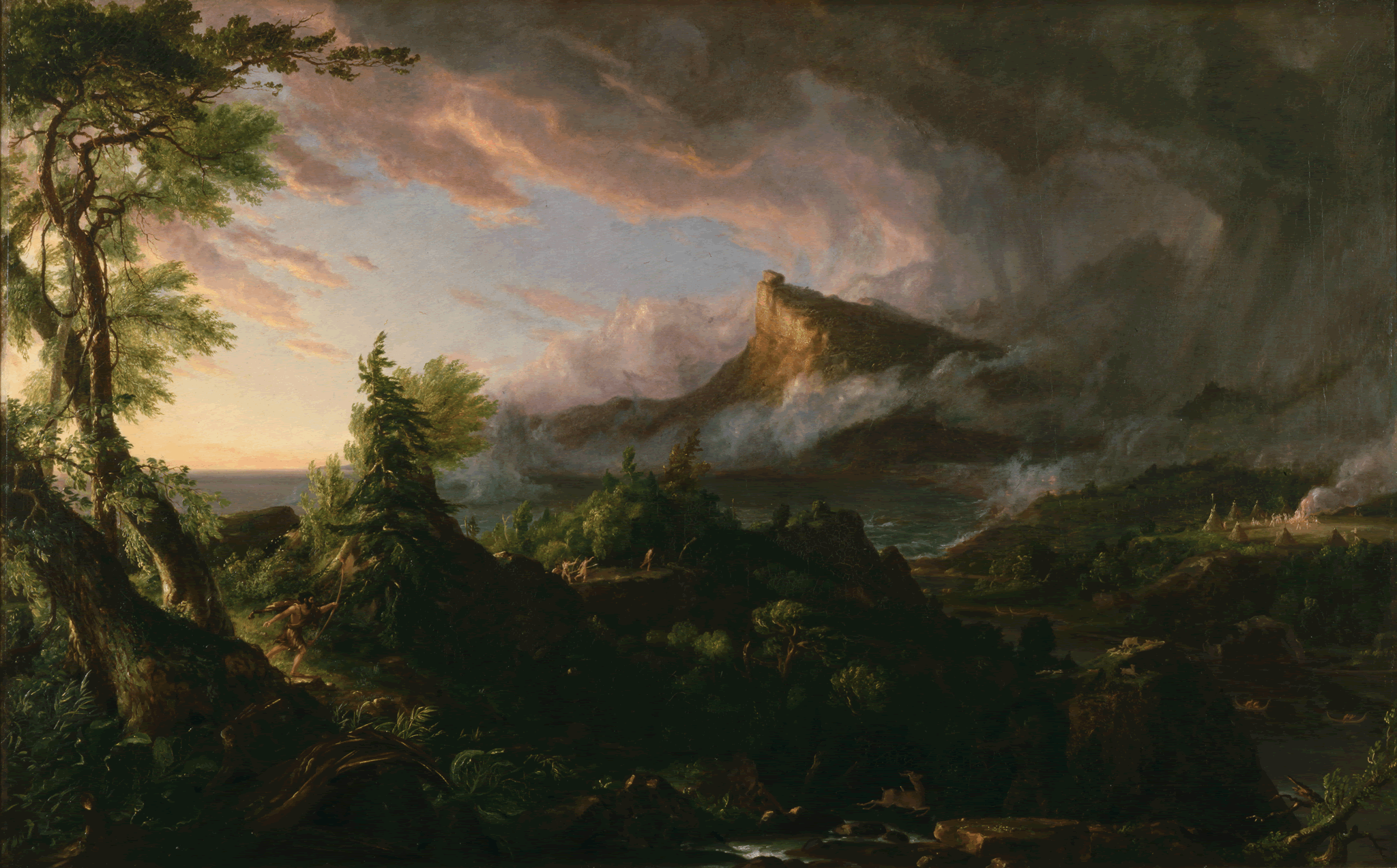The Course of Empire: The Savage State

About
Decode
Compare
Cole's Process
Cole's Words
Locate
About
"The first picture, representing the savage state, must be a view of a wilderness,—the sun rising from the sea, and the clouds of night retiring over the mountains. The figures must be savage, clothed in skins and occupied in the chase. There must be a flashing chiaroscuro, and the spirit of motion pervading the scene, as though nature was just springing from chaos." 1
Decode
Mouse over the detail to view its caption, click it to zoom in, and use the reset button on the lower right to zoom back out.
1. This mountain appears in every painting of The Course of Empire. Here, Cole places it in the center of the composition, surrounded by storm clouds. Its powerful form suggests that nature is supreme in the savage state. The enormous boulder balanced on its peak may signify the precarious state of humankind in relation to all-powerful nature.
2. Cole's conception of "primitive" man is a nomadic hunter, with a bow and arrow, pursuing a deer.
3. A deer, injured by the man's arrow, attempts to flee. This is an indication of man's efforts to dominate nature, a theme played out in the subsequent paintings in the series.
4. This ghostly figure of a hunter is a pentimento (from the Italian word pentirsi, meaning "to repent"). This form reveals traces of a previous idea about the placement of figures in The Savage State. Cole changed his mind about this figure and painted it over, but now that the pigments have aged, evidence of the artist's original thoughts about the compositionreappear.
5. In this encampment with teepees, native people dance around a fire. The circular form of the teepees recalls Cole's Scene from "The Last of the Mohicans," Cora Kneeling at the Feet of Tamenund, inspired by James Fenimore Cooper's novel.
6. Storm clouds symbolize the wildness of nature.
7. Primitive canoes are an allusion to the beginning of transportation and exploration.
8. In the hunter-gatherer stage, men have banded together for the mutual necessities of protection, sustenance, and worship.
Compare
Salvator Rosa, Rocky Landscape with a Hunter (Paysage rocheux avec un chasseur), oil on canvas, 1615-1673, 55 9/10 x 75 3/5 in. The Louvre, acquired 1816. View in Scrapbook
Cole saw many different paintings on his trip to Europe in 1829-32. He was particularly interested in the wild landscapes of the Italian Baroque artist Salvator Rosa (1615-73), with their dramatic rocky crags, broken tree branches, and stormy skies. In 1832, the New-York Mirror reported that Cole had returned from Europe with "two original paintings by Salvator," although these were most likely copies. Paintings such as Rosa's Rocky Landscape with a Hunter—which was in the Louvre's collection at the time of Cole's trip—were primary influences on Cole's The Savage State, which displays a similar use of natural elements to convey a sense of drama. 1 For landscapists of Cole's time, Rosa's work exemplified the aesthetic features of the sublime.
Process
Cole began sketching ideas for The Course of Empire as early as 1829 and ruminated on the series throughout his first trip abroad. In 1832, he sent A Wild Scene to Robert Gilmor, Jr., of Baltimore, describing it as "a large picture representing a romanticcountry, or perfect state of nature, with appropriate savage figures. It is a scene of no particular land, but a general idea of a wild." 1
A Wild Scene became the basis for The Savage State, with its similar mountain peak, storm clouds, primitive hunters, and fleeing deer. 2 But the art historian Ellwood C. Parry points out that in the Study for the Savage State, Cole shifted the large framing tree from right to left and reversed the orientation of the figure on the far left toward the center of the composition. These changes take into account the intended placement of the work in relation to the other paintings in the series, as they direct the viewer's attention to the hub of the interrelated compositions. 3
Works
1. Thomas Cole, A Wild Scene, oil on canvas, 1831-32, 50 ½ x 76 in. Baltimore Museum of Art. Leonce Rabillion Bequest Fund, by exchange, and Purchase Fund. View in Virtual Gallery
2. Thomas Cole, Study for the Savage State, oil on canvas, c. 1834, 7 3/8 x 10 ¼ in. The Art Museum, Princeton University, Frank Jewett Mather, Jr. Collection. View in Virtual Gallery
3. Thomas Cole, The Course of Empire: The Savage State, oil on canvas, 1834, 39 ½ x 63 ½ in. Collection of The New-York Historical Society, 1858.1.
Words
... And to this state our western world is fast approaching; but nature is still predominant, and there are those who regret that with the improvements of cultivation the sublimity of the wilderness should pass away: for those scenes of solitude from which the hand of nature has never been lifted, affect the mind with a more deep toned emotion than aught which the hand of man has touched. Amid them the consequent associations are of God the creator—they are his undefiled works, and the mind is cast into the contemplation of eternal things. 1
Find it here.
